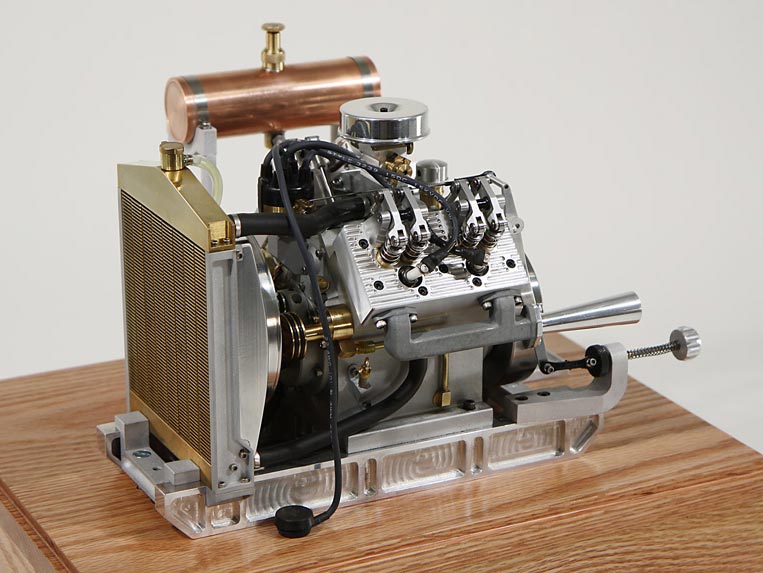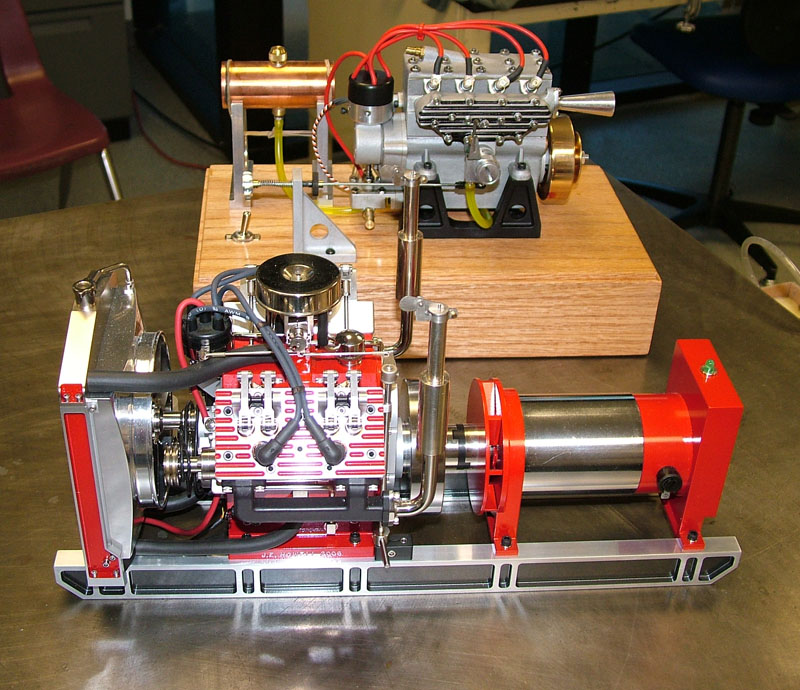The Howell V-4 Engine Project
Building a Howell V-4 Internal Combustion Engine
The Craftsmanship Museum’s Second Group Shop Project is a Success
The project featured on this page took about two and a half years to build. It was built in the Craftsmanship Museum machine shop, but parts were contributed by a group of different craftsmen. For the second museum shop project, we built a V-4 internal combustion engine designed by Jerry Howell. We have documented the build on this page, and recognized the craftsmen who made it happen. Many photos and descriptions of the process have been provided as a teaching experience.
Jerry Howell’s original V-4 prototype. The finish on Jerry’s model is so perfect that we knew this would be a tough act to follow.
Starting the Howell V-4 Engine Project
The Joe Martin Foundation began construction of a second internal combustion 4-cylinder engine in September, 2007. The Howell V-4 engine is now finished and part of the museum’s collection in Carlsbad, CA. We started by obtaining a set of plans from the engine’s designer, Jerry Howell.
Tom Boyer of the museum’s shop once again acted as both lead machinist and job coordinator. We invited several model engineers to participate in this project with us. A list of contributors can be seen below; however, for this second project a large majority of the engine was built by Tom Boyer.
Engine Specifications
- Designer: Jerry E. Howell, Colorado Springs, CO
-
Type: 4-cycle, water cooled, twin cam, 90° V-4
-
Size: 7.6″ L (with radiator) x 5.75″ W x 7.07″ H (on skid)
-
Displacement: 1.95 cu. in. (32 cc)
-
Bore: .875″
-
Stroke: .812″
-
Flywheel Diameter: 3.0″
-
Carburetor: 2 jet
-
Ignition: Hall effect distributor
-
Fuel: 30% white gas, 70% methanol
-
Start Date: 09/25/07
-
First Pop: 03/16/10
From left to right are Jerry Howell, Tom Boyer, and Joe Martin. In October, 2007 Jerry Howell visited the Miniature Engineering Craftsmanship Museum and met with shop craftsman Tom Boyer, and founder Joe Martin. Jerry stopped by the museum for a visit, and brought along his prototype V-4, which inspired us to build this project. We regret to add that Jerry passed away on August 29, 2009, before seeing the first running of the foundation’s Howell V-4.
Video of Jerry’s Engine Running
Watch a video below of Jerry’s own V-4 engine being run. Jerry disconnected the battery, so the starter became a generator that powers two light bulbs, and then revved the engine.
Video of the Joe Martin Foundation Howell V-4 Engine
Watch a video of the first pop for the Miniature Engineering Craftsmanship Museum’s Howell V-4 engine.
The Build Team
View a list of the build team members for the Howell V-4 engine project, along with some of the components built by each craftsman.
Full Howell V-4 Engine Build
View our chronological documentation of the full Howell V-4 engine build. We have included many more photos of the construction process behind our running Howell V-4.






